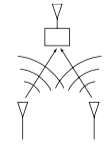Multi-user Uplink Channel

In the multiuser case, the concept of Channel Capacity is extended to Capacity Region: this is the set of all pairs $\left(R_1, R_2\right)$ such that simultaneously user 1 and 2 can reliably communicate at rate $R_1$ and $R_2$, respectively.
In the following two slides, principles of Orthogonal Multiple Access (OMA) and Non-Orthogonal Multiple Access(NOMA) will be discussed.
